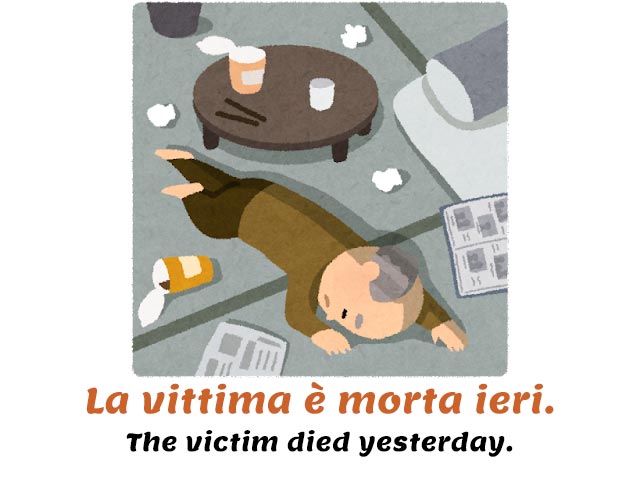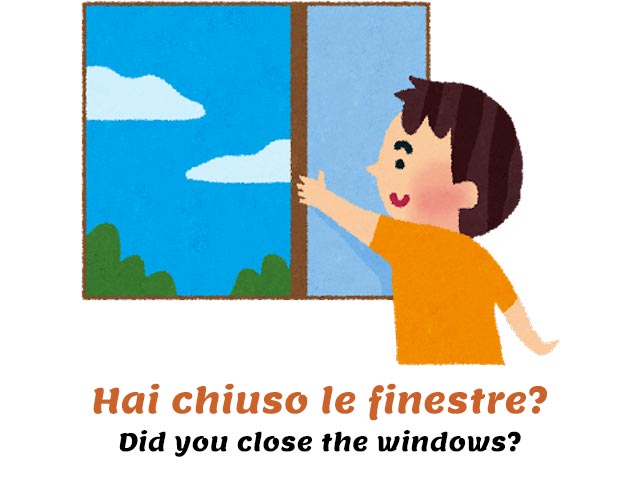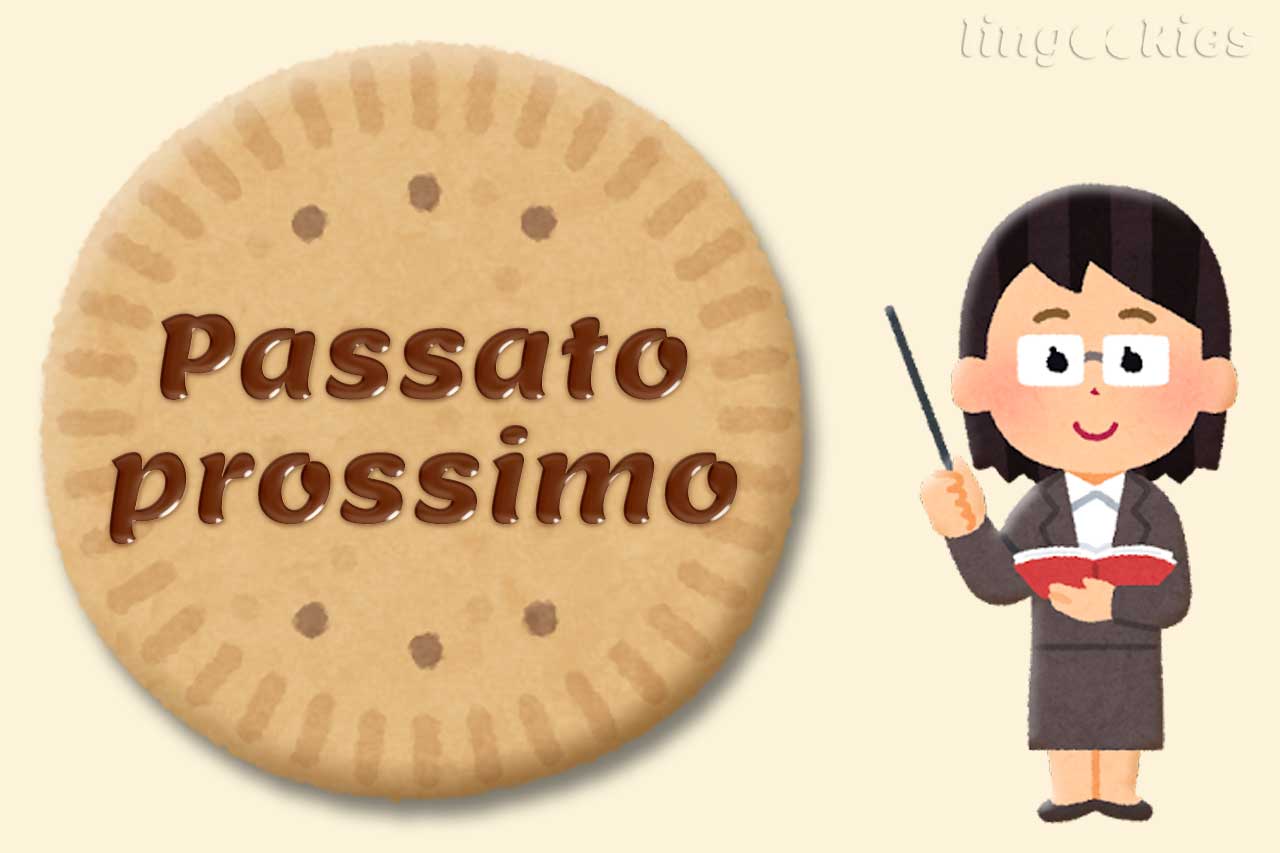Passato prossimo is the most common past tense in the everyday Italian language, so it’s very important that you learn it well if you want to talk about past events with your Italian friends.
Ho guardato un film.
I have watched a movie.

In this lesson, we will see how to form and when to use the passato prossimo in Italian.
Let’s get started! Iniziamo!
How to form the passato prossimo in Italian
In the spoken language, the passato prossimo is equivalent to the English present perfect and past simple tenses. It is mainly used to introduce events that took place in the past, but it can also describe events that are still relevant to the present.
Passato prossimo is a compound tense
Much like the present perfect tense in English, the passato prossimo in Italian is a compound tense because it’s made up of two verbs:
- the auxiliary verb, also known as the helper verb, in the present tense
- the past participle of the primary verb
If you’re not a pro at conjugating verbs in the Italian present tense, it might be useful to brush up on the conjugations of the Italian auxiliary verbs, essere and avere.
| essere (to be) | avere (to have) |
| io sono | io ho |
| tu sei | tu hai |
| lui/lei è | lui/lei ha |
| noi siamo | noi abbiamo |
| voi siete | voi avete |
| loro sono | loro hanno |

Let’s make a few examples with these conjugations! We will see how to form past participles in a moment.
Il cane ha morso un uomo.
The dog has bitten a man.
Marzia è caduta dalle scale.
Marzia fell down the stairs.
Avete chiamato la polizia?
Have you called the police?
Non sono mai stato a Venezia.
I have never been to Venice.

Since there are two auxiliary verbs to choose from, how do you know which one you have to use with a given past participle? Let’s see in the following paragraphs.
Verbs that use avere as an auxiliary verb
It’s mandatory to use avere as an auxiliary for all transitive verbs.
Transitive verbs are actions that can take a direct object, such as calciare (to kick), rompere (to break), or pulire (to clean).
Luca ha calciato il pallone.
Luca kicked the ball.
Luca ha rotto la finestra della sala.
Luca broke the window in the living room.
La mamma ha dovuto pulire il pavimento.
Mom had to clean the floor.
Literally: Mom has had to clean the floor.
The ball, the window and the floor are all direct objects. We could say that the direct object is the main “recipient” of the action. You will also be happy to know that most Italian past participles use avere.
Verbs that use essere as an auxiliary verb
It’s mandatory to use avere as an auxiliary verb in the passato prossimo tense for many intransitive verbs and all reflexive verbs.
Intransitive verbs are actions that can do without a direct object, such as iniziare (to start) or diventare (to become).
La lezione è iniziata un’ora fa.
The lesson started an hour ago.
La vittima è morta ieri.
The victim died yesterday.

You have to pay special attention to intransitive verbs that indicate a change of state and movement, such as:
- stare (to stay)
- andare (to go)
- scendere (to go down)
- salire (to go up)
- diventare (to become)
For example, you could say…
Il mio cane è diventato molto aggressivo.
My dog has become very aggressive.
Siamo andati allo zoo.
We went to the zoo.
Finally, you have to use essere with reflexive verbs. These verbs always end in –rsi, with -si being a reflexive pronoun. Examples of reflexive verbs are pettinarsi (to comb one’s hair) and addormentarsi (to fall asleep).
Mi sono pettinata i capelli.
I comb my hair.
Il pappagallo si è addormentato sul trespolo.
The parrot fell asleep on its perch.

How to form the past participle of Italian verbs
The past participle is the most important verb in the passato prossimo tense because it’s the verb that defines the action.
You form the past participle of regular verbs by removing the ending of the infinitive verb (-are, -ere are -ire) and adding –ato, -uto and -ito respectively, as in the table below.
| -are verb | root | past participle |
| mangiare | mangi- | mangiato |
| lavorare | lavor- | lavorato |
| portare | port- | portato |
| -ere verb | root | past participle |
| cadere | cad- | caduto |
| piovere | piov- | piovuto |
| dovere | dov- | dovuto |
| -ire verb | root | past participle |
| capire | cap- | capito |
| rapire | rap- | rapito |
| salire | sal- | salito |
For example, you could say…
Una biro è caduta sul pavimento.
A ballpoint pen fell on the floor.
Non ho capito. Potresti ripetere?
I didn’t get that. Could you repeat that?
Ho lavorato tutto il giorno.
I worked all day long.

Pitfalls of the Italian past participles
It’s very important to remember that passato prossimo verbs that want essere must match the subject in gender and number. These past participles basically behave like Italian adjectives. In this way, you will have four different past participles for any given verb.
| singular | plural | |
| masculine | salito | saliti |
| feminine | salita | salite |
Siamo salite sulle montagne russe.
We got on the roller coaster.
| singular | plural | |
| masculine | diventato | diventati |
| feminine | diventata | diventate |
Venezia è diventata una meta turistica molto popolare.
Venice has become a popular tourist destination.
This rule also applies to any past participle that precedes a direct object pronoun.
Hai pulito camera tua? – No, non l’ho pulita.
Did you clean your room? – No, I didn’t clean it.
(Camera is a feminine singular noun.)
Hai chiuso le finestre? – No, non le ho chiuse.
Did you close the windows? – No, I didn’t close them.
(Finestre is a feminine plural noun.)

Irregular past participles in the passato prossimo
There are quite a few irregular past participles in Italian, and the worst news is that many of them belong to very common verbs like aprire (to open), scrivere (to write), and vivere (to live).
Be sure to check out the list below featuring the most common irregular past participles used in the Italian passato prossimo! If you feel like it, you can also try your hand with the verb trainer exercises.
| infinitive verb | translation | past participle |
| aprire | to open | aperto |
| bere | to drink | bevuto |
| chiedere | to ask | chiesto |
| chiudere | to close | chiuso |
| correre | to run | corso |
| cuocere | to cook | cotto |
| dire | to say | detto |
| essere | to be | stato |
| fare | to do | fatto |
| leggere | to read | letto |
| mettere | to put | messo |
| morire | to die | morto |
| perdere | to lose | perso |
| prendere | to take | preso |
| ridere | to laugh | riso |
| rompere | to break | rotto |
| scegliere | to choose | scelto |
| scrivere | to write | scritto |
| smettere | to stop | smesso |
| vedere | to see | visto |
| venire | to come | venuto |
| vivere | to live | vissuto |
And that’s the end of our lesson on the passato prossimo in Italian! If you still have any doubts about this tense, feel free to leave a comment.
What next?
Now that you’ve seen the passato prossimo in Italian, you might want to keep learning Italian online with these free Italian resources:
- Useful Italian Words Series
- Common Italian Phrases Series
- Italian grammar lessons and tricks
- Italian idiomatic expressions
Or you might also want an excellent offline Italian grammar resource to take with you at all times (Amazon).
Title: Italian All-in-One For Dummies
Language: English / Italian
Publisher: For Dummies
Pages: 672
Learn to speak Italian like a native? Easy.
Italian All-in-One For Dummies appeals to those readers looking for a comprehensive, all-encompassing guide to mastering the Italian language. It contains content from all For Dummies Italian language instruction titles, including Italian For Dummies, Intermediate Italian For Dummies, Italian Verbs For Dummies, Italian Phrases For Dummies, Italian Grammar For Dummies, and Italian For Dummies Audio Set.
❤️ If you liked this guide on the passato prossimo in Italian, consider sharing it with your social media friends who are also studying Italian.




